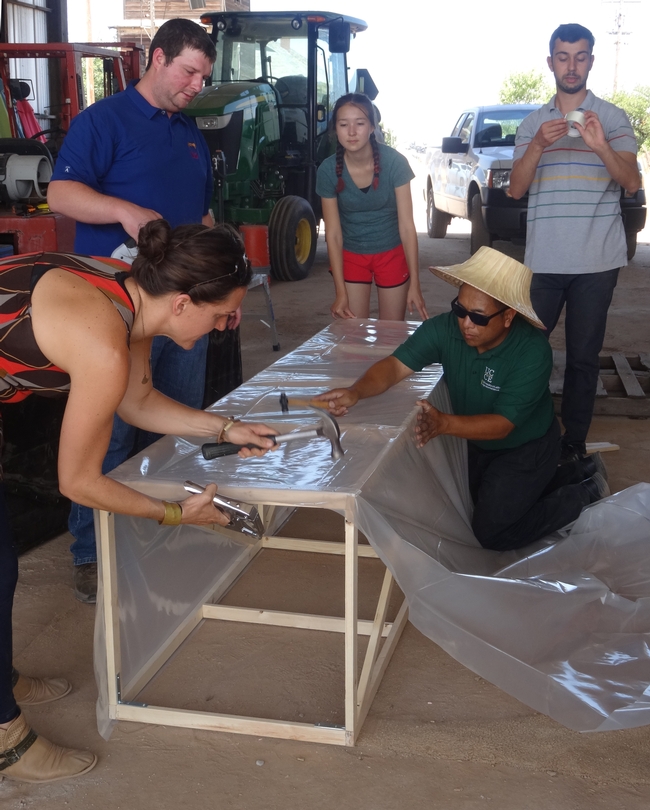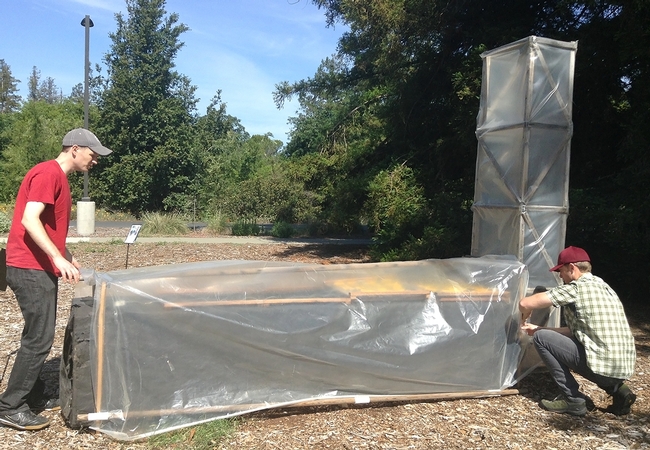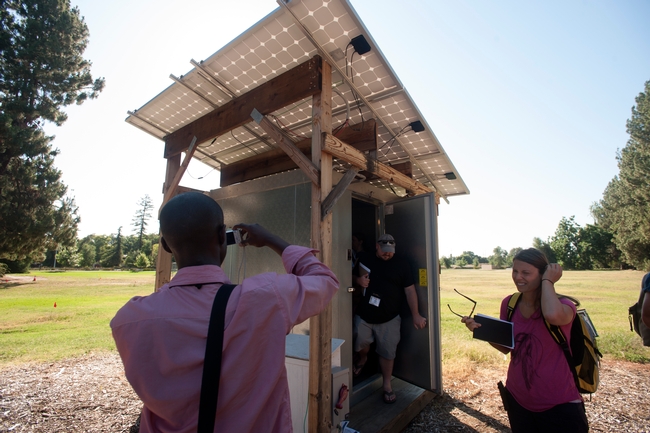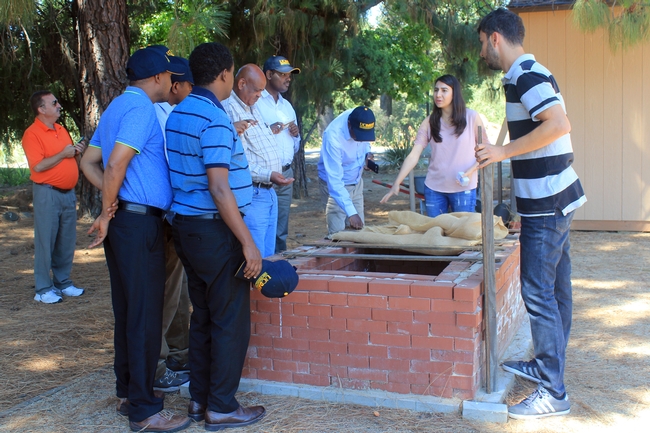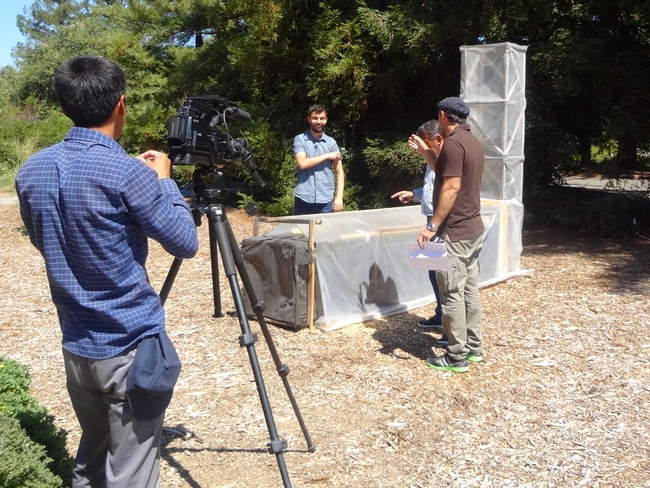
Posts Tagged: cold
Ever Seen a Mantidfly?
Ever seen a mantidfly, also called a mantisfly? Bohart Museum of Entomology associate John De Benedictis, aka "Moth Man," brought a mantidfly, an insect that's parasitic to spiders, to the museum on Tuesday. He collected it while blacklighting at the UC Davis Stebbens Cold Canyon Reserve,...
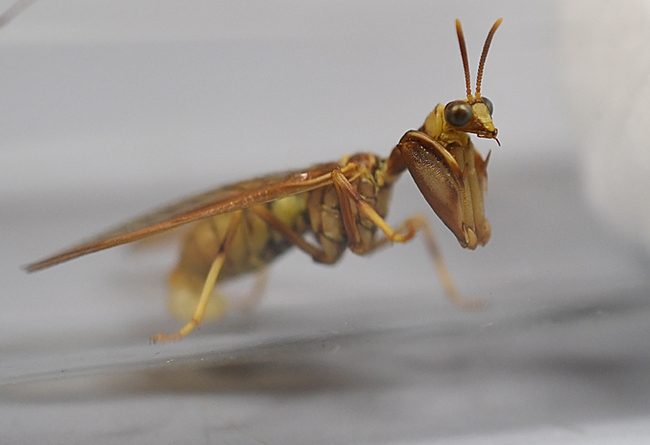
Mantidflies use their front legs to catch small insect prey. This one was collected by John De Benedictis at the UC Davis Stebbens Cold Canyon Reserve. (Snapshot by Kathy Keatley Garvey)
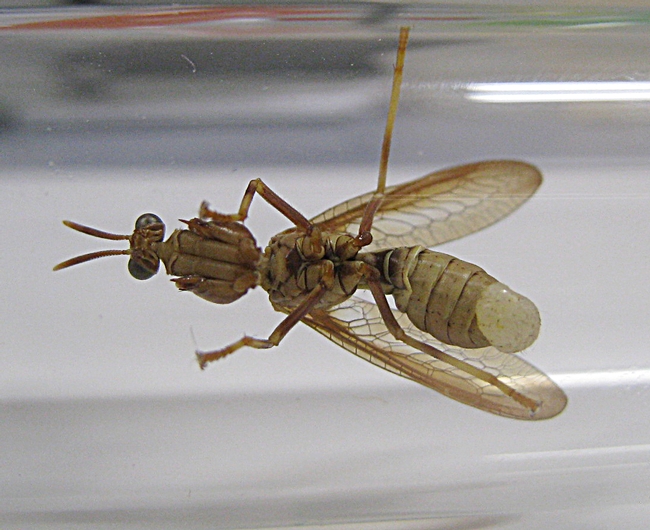
In coloring, the mantidfly abdomen resembles a paper wasp. (Photo by Kathy Keatley Garvey)
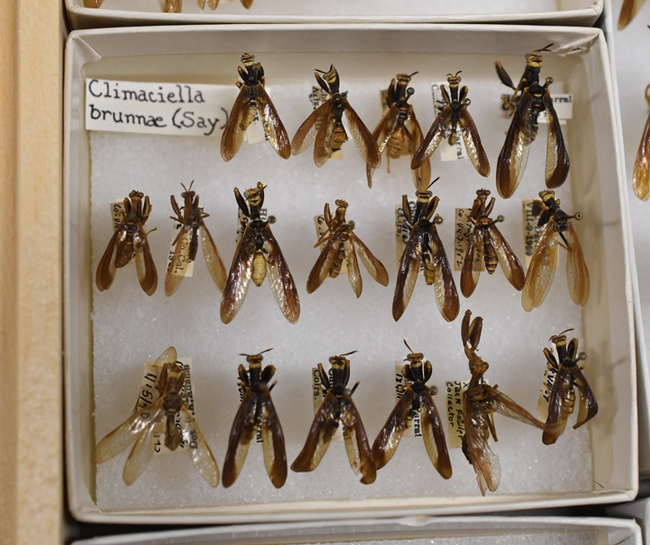
Part of the collection of mantidflies, Climaciella brunnea, at the Bohart Museum of Entomology. (Photo by Kathy Keatley Garvey)
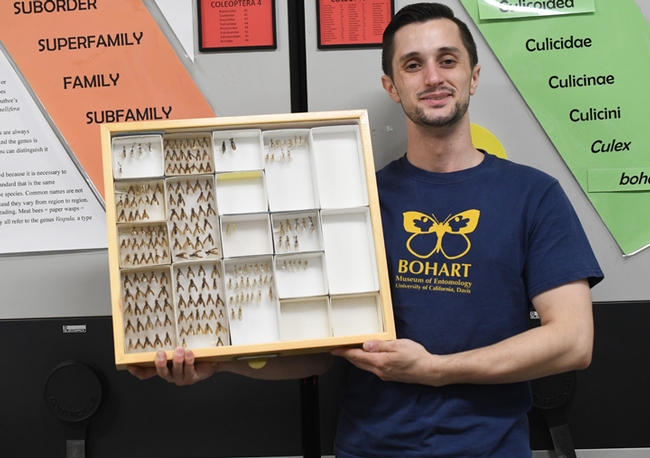
Bohart Museum of Entomology associate Wade Spencer holds a drawer of mantidfly specimens. The museum houses some eight million specimens, collected globally. (Photo by Kathy Keatley Garvey)
Explore tools that UC researchers use with smallholder farmers around the world
Planted in a corner of the UC Davis campus is a display of technologies and vegetable crops that researchers with the Horticulture Innovation Lab have been using with farmers in Africa, Asia and Central America. Led by UC ANR's Elizabeth Mitcham in the UC Davis Department of Plant Sciences, this program harnesses the agricultural expertise of a network of U.S. university researchers to improve how farmers in developing countries grow fruits and vegetables.
More often than not, the learning goes both ways: Adapting solutions for farmers on another continent can spark ideas that might be useful back home too.
So while the Horticulture Innovation Lab's Demonstration Center was built to showcase international work to campus visitors, you wouldn't be the first to wonder, “Would this technology work on a California farm too?”
Recently a team from UC Cooperative Extension in Fresno County — led by Ruth Dahlquist-Willard, UC Cooperative Extension advisor for small farms in Fresno and Tulare counties — worked with the Horticulture Innovation Lab to learn how to build one of these technologies, to try out with local farmers.
The low-cost technology they built, called a “chimney solar dryer,” combines continuous air flow with solar heat to dry fresh produce more efficiently than a traditional solar dryer. It was designed by the innovative duo Michael Reid and Jim Thompson, both emeritus specialists with UC Cooperative Extension who have worked on multiple inventions with the Horticulture Innovation Lab. The chimney solar dryer is usually built with basic materials, such as plywood, dark plastic, clear plastic, and food-grade mesh. Read more about how the chimney solar dryer can help farmers add value to crop surplus (PDF).
Here is a quick look at a couple of other technologies that visitors can see at the demonstration center:
This solar-powered cold room uses a tool designed by an American farmer, called a CoolBot. In a well-insulated room, a CoolBot can trick a household air conditioner into bringing temperatures down low enough for cool storage of fresh produce. Cooling fruits and vegetables soon after harvest from the field can reduce postharvest losses and extend shelf life. So far teams with the Horticulture Innovation Lab have used the CoolBot with farmers in Tanzania, Zambia, Uganda, Thailand, Cambodia, Bangladesh, India and Honduras.
Read more about how this farmer's invention is reducing postharvest losses around the world.
The zero-energy cool chamber (known as ZECC) is a simple structure built from brick and sand that can help cool fresh produce, in conditions where evaporative cooling is effective. By regularly wetting the sand and brick, farmers or even marketers can keep the temperatures low and the humidity high for fresh produce such as leafy greens. Researchers with the Horticulture Innovation Lab have been testing what specific conditions — such as hot, arid climates with easy access to water — make this tool effective for farmers to use to cool their fresh fruits and vegetables.
More information about the ZECC is available from the UC Postharvest Technology Center.
Recent visits to the Horticulture Innovation Lab's demonstration center have come in many shapes and sizes — from people walking by who stopped to read some of the signs, to group activities planned in advance. Recent tours of the center have included a delegation of deans from agricultural colleges in Ethiopia, a television news crew from Tajikistan and high school students from California learning about innovation and human-centered design.
Next time you're on the UC Davis campus, consider dropping by the Horticulture Innovation Lab demonstration center. You can find it on the campus map, or contact the team for a more focused tour.
Maybe it will spark an innovative idea that you can use in your fields?
More information:
- More recent blog posts about the Horticulture Innovation Lab Demonstration Center
- Explore the African vegetables on display
- Learn more about the technologies on display
- Get updates from the Horticulture Innovation Lab's email newsletter
Led by UC Davis, the Horticulture Innovation Lab is funded by the U.S. Agency for International Development (USAID) as part of Feed the Future, the U.S. government's global hunger and food security initiative.
How Cold Is It? Ask Siri and Check for Bees
Have you ever asked Siri "How cold is it?" Siri, a computer program known as Apple's "intelligent personal assistant" or "knowledge navigator," is part of Apple's Inc.'s iOS operating system. Folks usually ask Siri for directions. We ask about the weather AND directions. So on Wednesday noon,...
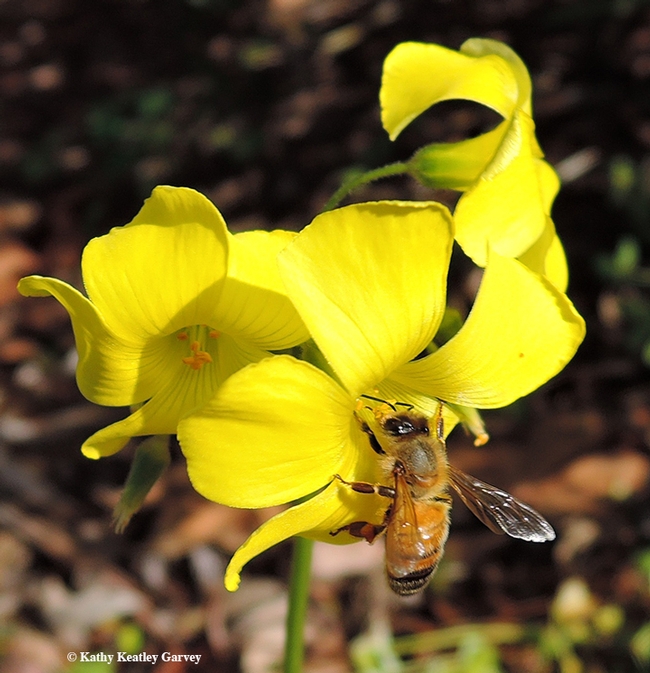
A honey bee foraging on oxalis at noon on Wednesday, Jan. 25 in Vacaville, Calif. Temperature: 53 degrees. (Photo by Kathy Keatley Garvey)

Pollen-packing honey bee on oxalis. (Photo by Kathy Keatley Garvey)
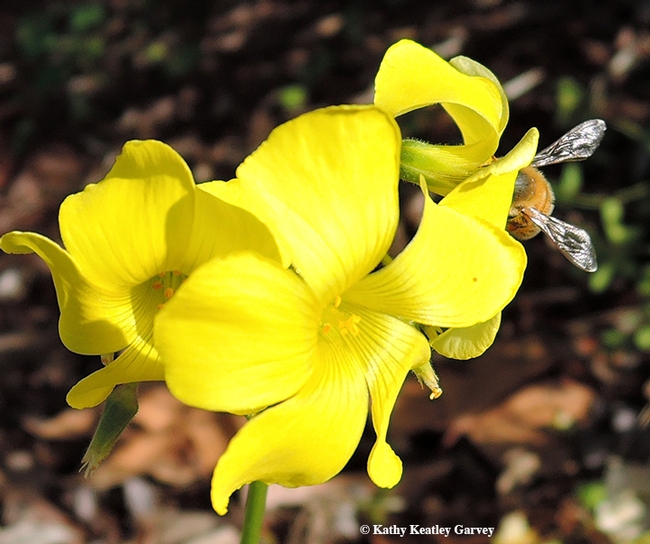
There she is! Silvery wings and all. (Photo by Kathy Keatley Garvey)
Conservation organization California Trout helps establish endowed chair at UC Davis
California once teemed with millions of native salmon, trout and steelhead. The state has 31 distinct types of these iconic, majestic fish. But decades of degradation to aquatic habitat has depleted their numbers in many areas of the state. According to a report by UC Davis fisheries professor Peter Moyle and colleagues, 20 of these fish species are in danger of extinction within the next century. They are important species not just for the recreational or commercial benefits they afford, but also because they are a direct reflection of the health of the environment.
“Large self-sustaining populations of native salmon and trout are found where streams are in reasonably good condition,” Moyle wrote in his 2008 report, “SOS: California's Native Fish Crisis.” This report was commissioned by the conservation organization California Trout (CalTrout), which exists to support conservation science, education, and advocacy efforts to protect California's water resources and fisheries.
Moyle, whose academic home is the Department of Wildlife, Fish and Conservation Biology at UC Davis, is no stranger to CalTrout. He is the foremost authority on California's native freshwater and anadromous (sea-run) fishes and has been a leader in research and conservation efforts. His research has provided the core science essential to statewide conservation planning for freshwater and estuarine native fishes, especially salmon and trout. Graduate students who studied with Moyle now occupy many top-level fish ecologist and management positions in state and federal agencies, as well as key nonprofits like CalTrout.

In May of this year CalTrout and UC Davis announced the formal creation of the Peter B. Moyle and California Trout Endowed Chair in Cold Water Fishes. The endowment will provide crucial support for the chair holder's scholarly activities, teaching, and public service involving cold water fish and aquatic ecosystems. He or she will teach department courses, mentor graduate students, conduct research and outreach, and provide leadership in the conservation of cold water fishes and their ecosystems. The university recognizes that salmon, trout, and steelhead are the major drivers of many conservation efforts and will have the highest priority in the chair's program.
Most of the contributors to the endowment are CalTrout board members such as Nick Graves. He and his wife, Mary, explored many trails and trout waters in the Sierra Nevada over the years and have enjoyed larger rivers flowing from the Trinity Alps, Mt. Shasta, and the Siskiyou Mountains. “The opportunity to create a scientific chair whose research targets California waters, in perpetuity, is a comforting thought,” Graves said.
“I have worked with the organization since its earliest days and have always admired the dedication of its members to aquatic conservation,” Moyle said. “I am biased, of course, but I think CalTrout has made a very smart investment in the future by creating an endowed chair.”
More Risky Business
If you’ve been reading our “Farming in the Foothills” blog over the last year, you’ll know that commercial farming is inherently risky profession. My fellow farmer Molly Nakahara (of Dinner Bell Farm) did a great job of describing farming risk in her October 28 post, “Farming, the Original Risky Business.” We farmers and ranchers face numerous uncertainties – from the weather to the marketplace to the regulatory environment. Some of these risks are short-term – like the snow storm that cancelled last weekend’s farmers’ market in Auburn. Some are long-term – like the potential impacts of new federal food safety standards on direct-market growers. Some risks can be eliminated, while others can only be mitigated. Our success as farmers and ranchers, in large part, depends on our success in managing these risks.
As a sheep rancher, there are two weather-related risks that foremost in my mind at the moment – one short-term and one long-term. As we wrap up our fall lambing season, we are in the midst of our regular early December cold snap. While the first week of December usually brings some of the coldest temperatures of the year, this year’s cold snap is especially severe and protracted. Since December 4 in Auburn, our morning lows have been in the teens, and our daytime highs have been in the high thirties or very low forties. At McCormack Ranch in Rio Vista, where we are lambing, the temperatures haven’t been much warmer. The cold weather presents a number of challenges: lambs that aren’t getting enough mother’s milk can quickly succumb to hypothermia. Lactating ewes that aren’t getting enough drinking water won’t produce as much milk. The sheep have to consume more feed just to maintain body temperature (let alone produce milk), so their feed demand increases.
From a longer-term perspective, we appear to be in the midst of a protracted drought. While we had a bit of rain in September, this fall has been dryer than normal. We finally got a germinating rainfall in mid-November – just in time for the weather to turn cold and the grass to go dormant. As a grass-farmer, I depend on fall grass growth to get our sheep through the winter months – and this year we didn’t get much growth. As we look toward next year, I’m very concerned that we may not have enough irrigation water to carry us through the summer months. The Nevada Irrigation District (NID) recently reported that we just experienced the driest January-November period in the district’s history – just over 20 inches of precipitation fell in NID’s upper watershed in the past 11 months. Unless we catch up soon, we may be facing reduced water deliveries next summer.
Obviously, these challenges can make for depressing conversations with other farmers, but there are some strategies we can use to mitigate (rather than eliminate) these risks. The weather is beyond our control, but our response to these conditions is not. Here are a few of the things we’re doing to manage these risks:
Short-term – sub-freezing temperatures
- As soon as we saw the forecast for sub-freezing temperatures, we moved the ewes who had not lambed into more sheltered paddocks. Lambs and ewes can deal with cold temperatures as long as they can avoid windy and wet conditions. These paddocks also had plentiful forage, which ensured sufficient feed intake for lactation and body temperature maintenance.
- We wrapped all of the pipes on the ranch to reduce the possibility of breakage (and subsequent time-consuming repairs). We also placed extra troughs in each paddock that we could reach with a hose from the water truck – if the permanent troughs froze, we could at least fill the temporary troughs from the truck.
- We moved the ewes with older lambs into the hills and increased the amount of hay we were feeding – again, to maintain milk production.
Long-term – drought
- We usually plan on culling 10-15 percent of our older ewes and replacing them with ewe lambs. We’ve been expanding our flock over the last several years, which means we cull fewer ewes and keep more ewe lambs. This year, we’ll consider culling more deeply – perhaps 20-25 percent of our ewes will be sold once we’ve weaned their lambs. We’ll also only keep ewe lambs out of our best and most productive ewes. While this will reduce our sheep inventory in the short-term, it will improve the overall productivity of our flock (measured in terms of lambing rate and pounds of lamb raised per ewe) over the long-term. Drought, then, allows us to improve the genetics of our flock.
- We’ll once again limit the number of lambs that we’ll keep to finish on grass and market directly to customers. As in 2013, we’ll base our decision on the amount of high quality summer forage likely to be available to us.
- We’ll evaluate the potential to invest in more efficient irrigation technology, like pod sprinklers. If we can make our irrigation water go further, we can grow more forage.
- Finally, we’ll also look for opportunities to graze alternative forages. This year, we’ve grazed crop residues and green “weedy” forage at Amber Oaks Farm in Auburn. We’ve also grazed alfalfa stubble in Rio Vista. Grazing helps to manage pests (plants and insects) on these operations while providing our sheep with higher quality forage.
Even with a risk management plan, these are the types of things that keep farmers and ranchers awake at night. While rain and wind never fail to awaken me from deep sleep, they keep me awake all night if they come in the midst of lambing. That said, a systematic approach to considering risk and adjusting to real-world conditions is critical to a successful farming or ranching operation. Ultimately, risk is just one of the many reasons that Tom Cruise isn’t a farmer.

